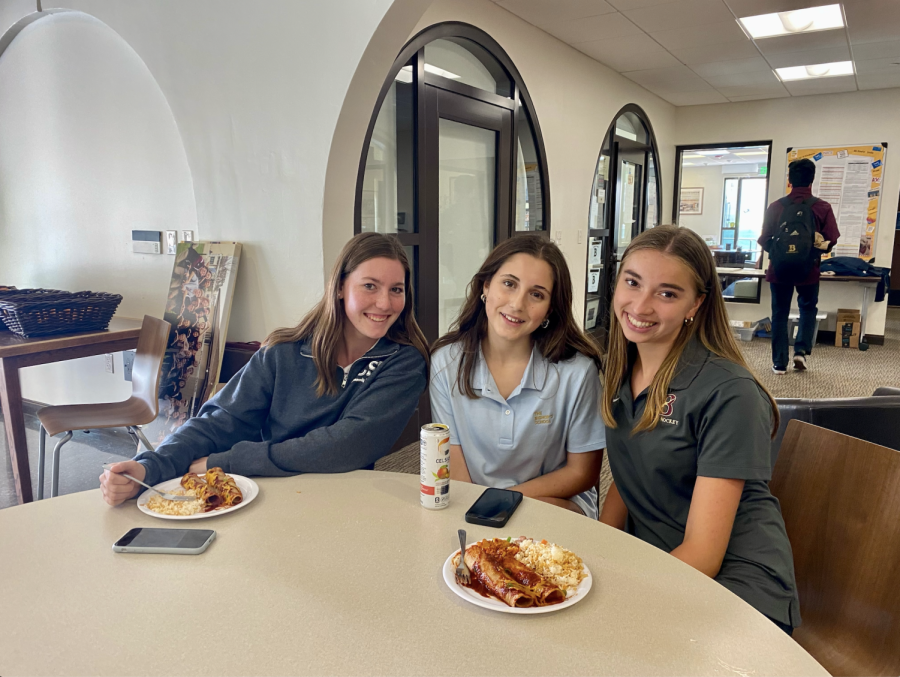Food for Thought…
Broadening cuisines or losing traditional connections?
No matter the cuisine, students enjoy spending time with each other during the school day over a meal. Juniors (pictured from left to write) Kylie Larson, Bella Gallus, and Lily Gover smile over plates of enchiladas and Spanish rice.
Food is so much more than just fuel for your body; it’s an unspoken language. A way of wrapping your family and friends in love. A way of bringing your children and later grandchildren into your childhood memories. A way of keeping your culture alive.
The United States is a global melting pot of people, traditions, and cultures. And with them, comes a delicious variety of international foods. However, international dishes often shift in America to appeal to the average American. The popularity of hard shell tacos over traditional corn tortillas is an example of “Americanization.” But through this inevitable process, are we broadening cuisines or simply losing cultural connections?
The answer is more complex than it may seem. A majority of this confusion rises from the discrepancies in what an authentic dish in America actually means. Truman State University sociologist Dr. Stephen Christ spent two years researching this question. After interviewing staff at 54 Mexican restaurants across the country, Dr. Christ came to a conclusion. “A restaurant is only as authentic as profits will allow,” he shared in a Bloomberg article summarizing his study.
Sophia Ling, a writer from The Emory Wheel added, “authenticity in food is about hominess.” It’s about what a dish feels like. These discrepancies are what make it difficult to determine if Americanized cuisine is a good thing.
Over the years, various international cuisines have undergone vast changes in America, but not by the same degree. French cuisine in America has stayed more or less consistent, according to Ava Bradley (‘24), a French-American. Because France is a European country, she believes that people see the nation’s cuisine as already prestigious. In a New Yorker article, Lauren Collins, a reporter specializing in French Culture, explained, “In the American imagination, French cuisine can seem a static entity–the inevitable and unchanging expression of a culture.”
“What you see in America is the easier version of that food,” Ava continued. Besides the Eiffel Tower, of course, France is well known for its attention to detail in the culinary arts. In the US, corners get cut while making French dishes, Ava noted. The results in the States are significantly different from what a native French person would expect in France.
In a Forbes article, Alex Ledsom, a senior contributor with a background in research added, “[But] in its defense, French cuisine can be technically difficult to master and with the proliferation of so many French restaurants, kitchens don’t have the skills to deliver.”
On the other hand, there are other cuisines that have been drastically Americanized. One of the most well-known Americanized cuisines is Tex-Mex, a cuisine filled with nachos and burritos, neither of which are native to traditional Mexican cuisine. The cuisine has since led to the wide-spread popularity of hard-shell tacos.
The San Francisco Weekly spoke with two taco experts to find out the origins of the “anglo taco,” another name for the U-shaped taco shell, in 2011. Glen Bell–a man with European heritage, not Hispanic heritage–the founder of Taco Bell, first made the shape popular. The shell was mass-produced and took the nation by storm.
But why were these dishes Americanized in the first place? Alex Gomez (‘23) said that it’s likely because “Americans like to put things they’re used to on unfamiliar dishes.” Jackie Simone, a writer for Buzzsaw Magazine, wrote about how Thai cuisine is becoming more popular in the US. Yet Thai chefs have to choose between “retaining their traditions and becoming an economically successful American.” She added, “In order to achieve the American Dream of economic prosperity, they must surrender part of their own culture.”
Thus, it’s common to see restaurants slowly introduce unfamiliar dishes to consumers by adding nontraditional aspects. In other words, restaurants will add ingredients that make culturally authentic dishes familiar to the American taste.
And in the end, it’s about keeping an open mind, Marcus Buu-hoan (‘24) added. Try out new restaurants in your area that focus on traditional cooking practices and dishes, but also experiment with fusion restaurants. It’s all good food at the end of the day.

Sydney Chan is an Editor-in-Chief for The Tower dedicated to discovering unique stories and bringing them to life through her pieces. She especially loves...







